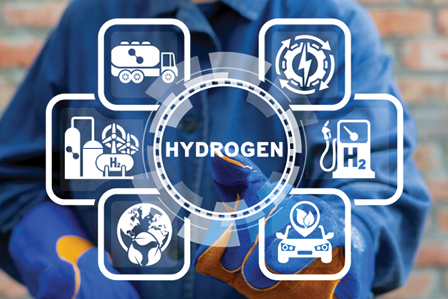
California will receive up to $1.2 billion from the U.S. Department of Energy to accelerate the development and deployment of clean renewable hydrogen, critical to cutting pollution and expanding the clean energy economy statewide.
California is one of seven regions selected by the federal government to be a “hydrogen hub.” The California Hydrogen Hub spans from Southern California to Northern California and encompasses three ports: Los Angeles, Long Beach and Oakland.
One goal is to power sites like the state’s busy ports with carbon free power. Officials estimate that will cut two million metric tons of carbon emissions—equivalent to the pollution of 445,000 gasoline-powered cars annually. Hydrogen also will be key in heavy-duty trucking and trucks transporting goods from ports.
The Alliance for Renewable Clean Hydrogen Energy Systems (ARCHES), a statewide public-private partnership to build the framework for California’s renewable clean hydrogen hub, anticipates to partner with more than 400 organizations representing civic, business, labor, transportation, and communities across the state. It estimates these projects will create more than 200,000 new jobs and will ultimately result in $2.95 billion per year (starting in 2030) in economic value, including increased health and health-care cost savings due to significant reductions in air pollution.
Hydrogen Hub Program
President Joe Biden’s Bipartisan Infrastructure Law includes $65 billion in clean energy investments at the Department of Energy, including $8 billion for a Regional Clean Hydrogen Hubs Program to support the development of hubs for clean hydrogen production, delivery, and end-use.
Hydrogen can be produced from diverse domestic resources like solar energy, wind, nuclear energy, biomass, and natural gas with safe and responsible carbon capture, with the potential for near-zero greenhouse gas emissions from production.
The program allocates $7 billion toward developing the regional clean hydrogen hubs that will catalyze multistate hydrogen ecosystems that ultimately will expand and connect to form a national hydrogen economy. Up to $1 billion of the remaining funding will be used for demand-side support for the hubs to drive innovative end-uses of clean hydrogen.
The hubs selected for the federal program are:
• California Hydrogen Hub (California): The California Hydrogen Hub will leverage the Golden State’s leadership in clean energy technology to produce hydrogen exclusively from renewable energy and biomass. It will provide a blueprint for decarbonizing public transportation, heavy-duty trucking, and port operations—key emissions drivers in the state and sources of air pollution that are among the hardest to decarbonize. This hydrogen hub has committed to requiring Project Labor Agreements for all projects connected to the hub, which will expand opportunities for disadvantaged communities and create an expected 220,000 direct jobs—130,000 in construction jobs and 90,000 permanent jobs.
• Mid-Atlantic Hydrogen Hub (Pennsylvania, Delaware, New Jersey): The Mid-Atlantic Hydrogen Hub will help unlock hydrogen-driven decarbonization in the Mid-Atlantic while repurposing historic oil infrastructure and using existing rights-of-way. It plans to develop renewable hydrogen production facilities from renewable and nuclear electricity using both established and innovative electrolyzer technologies, where it can help reduce costs and drive further technology adoption.
• Appalachian Hydrogen Hub (West Virginia, Ohio, Pennsylvania): The Appalachian Hydrogen Hub will leverage the region’s ample access to low-cost natural gas to produce low-cost clean hydrogen and permanently and safely store the associated carbon emissions. The strategic location of this hydrogen hub and the development of hydrogen pipelines, multiple hydrogen fueling stations, and permanent CO2 storage also have the potential to drive down the cost of hydrogen distribution and storage.
• Gulf Coast Hydrogen Hub (Texas): The Gulf Coast Hydrogen Hub will be centered in the Houston region, the traditional energy capital of the United States. It will help kickstart the clean hydrogen economy with its plans for large-scale hydrogen production through both natural gas with carbon capture and renewables-powered electrolysis, leveraging the Gulf Coast region’s abundant renewable energy and natural gas supply to drive down the cost of hydrogen—a crucial step to achieving market liftoff.
• Heartland Hydrogen Hub (Minnesota, North Dakota, South Dakota): The Heartland Hydrogen Hub will leverage the region’s abundant energy resources to help decarbonize the agricultural sector’s production of fertilizer, decrease the regional cost of clean hydrogen, and advance the use of clean hydrogen in electric generation and for cold climate space heating. It also plans to offer unique opportunities of equity ownership to tribal communities through an equity partnership and to local farmers and farmer co-ops through a private sector partnership that will allow local farmers to receive more competitive pricing for clean fertilizer.
• Midwest Hydrogen Hub (Illinois, Indiana, Michigan): Located in a key U.S. industrial and transportation corridor, the Midwest Hydrogen Hub will enable decarbonization through strategic hydrogen uses including steel and glass production, power generation, refining, heavy-duty transportation, and sustainable aviation fuel. This hydrogen hub plans to produce hydrogen by leveraging diverse and abundant energy sources, including renewable energy, natural gas, and low-cost nuclear energy.
• Pacific Northwest Hydrogen Hub (Washington, Oregon, Montana): The Pacific Northwest Hydrogen Hub plans to leverage the region’s abundant renewable resources to produce clean hydrogen exclusively from renewable sources. Its anticipated widescale use of electrolyzers will play a key role in driving down electrolyzer costs, making the technology more accessible to other producers, and reducing the cost of hydrogen production.

